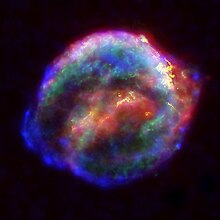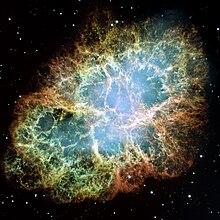Supernova


Supernova est lucidissima stella, nova ingens, id est stella cuius magnitudo sic crescit inter paucos dies ut nova stella apparere videatur. Praefixo super hoc vocabulum differt ab alio nova, quae designat stellam cuius intensitas luminosa crescit, sed modo minore et secundum viam alteram. Vocabulum supernova a Gualterio Baade et Fritz Zwicky? anno 1931 excogitatum est.[1]
Supernova collapsu magnae stellae gigni putatur, cum gravitati stellae nucleus cedit et in se ruit et externae flammae maxima vi proiciuntur in spatia.
A supernova foramen nigrum vel stella neutronica nasci potest. Foramen nigrum autem non nascitur, nisi astralis materiei tantum superest ut astri nucleus ob ipsius gravitatem collabi possit sic ut singularitas dimensionum spatii et temporis gignatur.
Notae[recensere | fontem recensere]
- ↑ Osterbrook 2001.
Bibliographia[recensere | fontem recensere]
- "Introduction to Supernova Remnants". NASA / Goddard Space Flight Center. 2007-10-04.
- Bethe, Hans A. (1990). "Supernovae". Physics Today: 43(9):736–739.
- Croswell, Ken (1996). The Alchemy of the Heavens: Searching for Meaning in the Milky Way. Anchor Books. ISBN 0-385-47214-5.
- Filippenko, Alexei V. (1997). "Optical Spectra of Supernovae". Annual Review of Astronomy and Astrophysics: 35:309.
- Hillebrandt, Wolfgang; Janka, Hans-Thomas; Müller, Ewald (2006). "How to Blow Up a Star". Scientific American: 295(4):42–49.
- Osterbrock, Donald E. 2001. Who Really Coined the Word Supernova? Who First Predicted Neutron Stars? Bulletin of the American Astronomical Society 33:1330.
- Takahashi, K.; Sato, K.; Burrows, Adam; Thompson, Todd A. (2003). "Supernova Neutrinos, Neutrino Oscillations, and the Mass of the Progenitor Star". Physical Review D: 68(11):77–81. arXiv:hep-ph/0306056.
- Thomas, Brian C. 2017. "Photobiological Effects at Earth's Surface Following a 50 pc Supernova." Astrobiology, 28 December 2017.
- Woosley, Stanford E.; Janka, Hans-Thomas (2005). "The Physics of Core-Collapse Supernovae". Nature Physics: 1(3):147–154. arXiv:astro-ph/0601261.
Nexus interni
